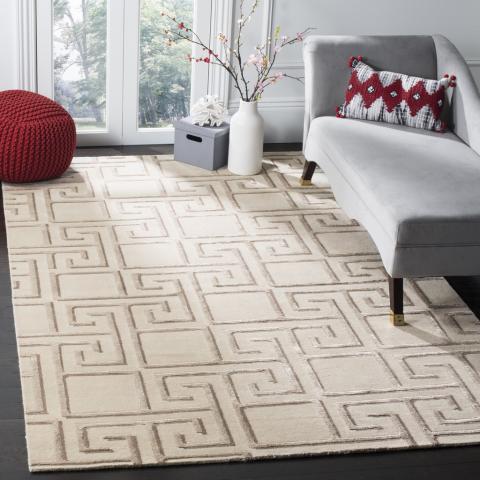Glossary
|
Abrash: A Change in the color of a rug due to differences in the wool or dye batch. The color change runs across the rug, and is most likely to occur at the top. |
|
Asymmetric knot: A knot that may be open to the right or the left. Also known as Persian or Senneh knot. |
|
Bamboo: A symbol of longevity; a favorite motif in Chinese art. |
|
Border: A design around the edge of a rug, surrounding the field. The border usually includes a wide bank with a repeating design, called the main border. |
|
Boteh: A pear-shaped figure often used in oriental rug designs. Characteristic of the paisley pattern, the boteh may represent a leaf, bush or a pine cone. |
|
Butterfly: A Chinese figure that connotes great age when used in conjunction with other symbols. |
|
Canary: A symbol of family togetherness, regarded as a good omen. |
|
Carding: The combing of fibers with wire bristle brushes prior to spinning. |
|
Cartoon: A grid on paper with colored spaces to guide rug weavers in the execution of a rug's design. |
|
Chain stitch: A crochet stitch used in rug construction that consists of successive loops to lock the final weft in place at the end of a rug. |
|
Chessboard: One of four emblems of literature and science. Others are the harp books and paintings. |
|
Cloud band: A curved, horseshoe-shaped motif in Chinese carpet, used especially to fill vacant spaces. |
|
Crocking: A loss of dye color at spots of friction or wear. |
|
Dhurrie: A flatwoven rug from India, usually made of cotton or wool. |
|
Endless knot: A bhuddist emblem symbolizing long duration, often used with other symbols. |
|
Farisbaff: An asymmetric, or Persian pile knot. |
|
Field: The part of a rug's design surrounded by the border. The field may be blank or contain medallions or an over-all pattern. |
|
Flatweave: Any rug woven without a knotted pile. |
|
Foundation: The combination of warps and wefts in the body of a rug. |
|
Fringe: Warps extending from the ends of a rug, which are treated in several ways to prevent the wefts and knots from unravelling. |
|
Ground: The interlaced combination of warp and weft that comprises the fabric. In pile rugs, the ground is referred to as the foundation. |
|
Guard stripe: Stripes or lesser borders on either side of the main border. |
|
Gul: A medallion, either octagonal or angular in shape, used in Turkman designs. It is often repeated to form an all-over pattern in the field. |
|
Herati pattern: A design consisting of a flower in a diamond, with leaves outside and parallel to the diamond's sides. |
|
Jufti knot: A knot tied over four warps instead of the usual two. |
|
Kenareh: The Persian term for a runner, 21/2' by 31/2'. |
|
Kilim: A tapestry-like woven rug. |
|
Kork: Any fine wool. |
|
Lotus flower: A Bhuddist emblem of summer, happiness and maturity, regarded as a sacred flower. |
|
Matn: The ground or field of a rug. |
|
Medallion: The large enclosed portion of a design, usually in the center. Typical shapes are diamonds, octagons and hexagons. |
|
Mercerized: Cotton thread whose strength and sheen have been enhanced by treating with alkali under pressure. |
|
Merino: A breed of sheep that produces very fine wool. Originally raised in Spain, merino sheep whose wool is used in rugs are also raised in Australia and England. |
|
Mina khani: An all-over design consisting of two or more flower blossoms connected by a diamond lattice. |
|
Mori: The weaving technique of certain Pakistani and Indian rugs. |
|
Naqsh: A design or pattern. |
|
Node: One loop of a pile knot around a warp seen from the back of the rug. |
|
Overcasting: A treatment of selvages where yarn is wrapped or interwoven with a yarn that is not part of the foundation weft. |
|
Painting: Applying dye or stain to the front of a rug after it is woven. |
|
Peace emblem: A round, maze-like symbol used in rug design that connotes peace and longevity. |
|
Peach blossom: An emblem of spring, which is considered the blossom of the fruit of life. |
|
Peach border: A dotted interior border pattern used as a frame to separate the center design from the outside border. |
|
Peony: The flower of wealth and respectability used in rug design. |
|
Pile: The nap of the rug, or the tufts remaining after the knotted yarns are clipped. |
|
Plain weave: The simplest interlacing of warp and weft. |
|
Plug: A piece of a rug sewn or woven into a hole of another rug. |
|
Ply: Two or more yarns spun together. |
|
Prayer rug: A rug with a representation of a mosque or arched prayer area. Columns may be shown supporting the arch with a lamp hanging from the arch's apex. |
|
Prunus: The plum blossom, a symbol of beauty that often symbolizes winter, used in rug design. |
|
Pushti: A Persian mat of about 3' by 2 '.Rofu: A Persian term meaning a repair that is not evident. |
|
Selvedge: The edge warps of a rug and the foundation weft around those warps. |
|
Soumak: A flatweave rug made from a technique that produces a herringbone effect. |
|
Spin: The direction of a yarn's twist. |
|
Staple: The average length of fibers in a yarn. |
|
Symmetric knot: A knot tied on two warps; also known as the Giordes or Turkish knot. |
|
Tapestry weave: Any variety of weaves where the pattern is created by ground wefts that do not run from end to end. |
|
Thunder line: A border pattern that stems from prehistoric hieroglyphics. |
|
Turn-arounds: Reversals in direction of the new wefts. |
|
Warp: Comprising the structure, parallel warp yarns run the length of the rug, and are interlaced with wefts. |
|
Warp-faced: A rug where warps are more closely spaced than wefts, and wefts are concealed. In a balanced plain weave rug, warps and wefts are equally visible. |
|
Warp offset: A technique where some warps are held tightly in place, while others are held in place loosely. |
|
Washing: A chemical solution used after weaving to soften a rug's colors and increase its luster. |
|
Weft: The yarns woven horizontally through the warps. |
|
Weft-faced: A rug where the weft yarns are more closely spaced than the warps. |
|
Weft twining: A weft wrapping method where two wefts pass across warps, twisting together after each wrap or at regular intervals. |
|
Whip stitch: A stitch used to overcase and lock the final weft in rug ends. |
|
Worsted: A wool yarn of long staple with fibers that have been combed prior to spinning. |

